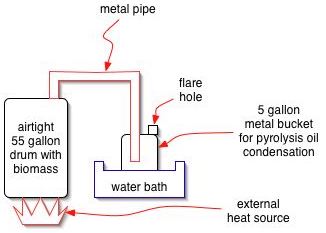Bio-Oil / Diesel Mixture Fuels: Difference between revisions
< Bio-Oil
Jump to navigation
Jump to search
(Created page with "326px|thumb|right|The vapors that come off can be sent into another drum, submerged in cool water for condensation to occur. Bio-oil is is...") |
m (categorized) |
||
| Line 1: | Line 1: | ||
{{Category=Biofuel}} | |||
[[File:Pyroil.jpg|326px|thumb|right|The vapors that come off can be sent into another drum, submerged in cool water for condensation to occur. ]] | [[File:Pyroil.jpg|326px|thumb|right|The vapors that come off can be sent into another drum, submerged in cool water for condensation to occur. ]] | ||
Revision as of 09:35, 8 March 2011
Bio-oil is is produced in the pyrolysis of biomass. It is a highly viscous, acidic fluid and has high water content, making it unsuitable for use in current diesel internal combustion engines. Upgrading is possible but tedious. Alternatively, bio-oil can simply be mixed with bio-diesel in an emulsion. This appears to dramatically improve some of the qualities and make the resulting fuel much more like bio-diesel than crude bio-oil.
